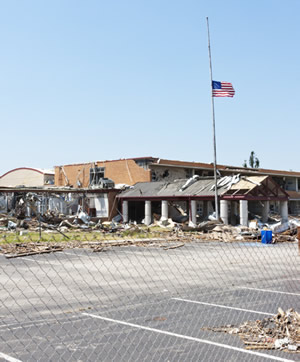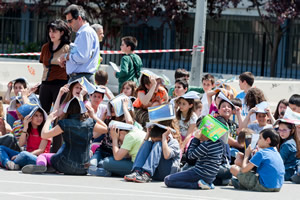Safety & Security (Prepare and Be Aware)
Planning Disaster Responses
- By Michael Fickes
- April 1st, 2019
Have you ever been through an earthquake? Many quakes are no more than small tremors. You feel the floor moving in a weird way for a few seconds and that’s it, it’s over.
Then there are big quakes that crack walls and knock down buildings and ceilings.
When the floor starts moving, though, you don’t know what you are in for. Is it a small tremor or a big quake?
Just in case it’s a big one, we all need a disaster response plan of some kind.
Of some kind? Yes. First thing to do in the event of an earthquake is to move outside and away from the building. Many quakes end in seconds, but you don’t want your students to remain inside if the shaking gets so bad that the ceiling caves in. So, walk outside and wait out the event in an open area away from buildings, trees, and other things that can be knocked over.
Usually the shaking will stop quickly, and everyone can go back inside.
That is one kind of disaster response plan.
More destructive earthquakes require more comprehensive disaster responses.
And, of course, different kinds of disasters can strike a school: an active shooter, a gas explosion, a tornado, you name it.
The point is that when a disaster arrives, you need to have a preplanned response that you can turn to—a response that will keep students and faculty as safe as possible.
How do you do that? How do you plan for a disaster? How do you even think about planning for a disaster?
Step one, according to experts, is to carry out a risk assessment.
Risk Assessments

PHOTO COURTESY OF STEVE FROEBE JOPLIN, Mo.
Chances are, school and school district officials will have a basic grasp of risks to school buildings throughout the district.
“Catalog the potential hazards that could affect your region and area schools,” says Vivian Marinelli, senior director of Crisis Management Services with FEI Behavioral Health, a company that creates a number of programs designed to assist employees, provide organizational development, prevent workplace violence, and manage workplace crises.
Consider, too, other hazards. What about, for instance, the potential air-quality problems that might arise in chemistry classrooms.
Another thought: how structurally sound is your school building and the outbuildings across your campus?
Marinelli also suggests surveying neighboring properties for things such as railroad tracks. What? While trains, rarely, run off the rails, they can, and if that happens and one or some of the cars carrying hazardous materials springs a leak, you may have to shelter students and faculty.
Other potential problems that neighbors might pose include factories or plants of some kind that use harsh chemicals in their processes.
None of this is to suggest that you fear everything. No. The idea, instead, is to learn what might happen and to lay in the supplies and practice the procedures that will provide protection against an event, rare though it might be.
Marinelli strongly recommends identifying an emergency response team capable of taking charge during an emergency. All students and faculty need to do is listen to them.
For example, what if the factory next door to a school accidentally releases a noxious gas? There must be a factory procedure that lets neighbors know about the problem. Once informed, the emergency response team will make sure that teachers close the windows in classrooms throughout the school. At the same time, the custodial staff, teachers, and administrators must close all air-intake vents and bring all gym classes and others who may be outdoors inside to shelter-in-place.
Shelter-in-place drills might be described as the opposite of fire drills, which move everyone out of the building.
“As with all kinds of safety drills, you need to develop step-by-step protocols and train for them,” says Michael Dorn, executive director of the Juliette-Ga.-based Safe Havens International, Inc. “You need to put steps in place to protect people, to communicate, to coordinate bus routes taking students to family pick-up locations, and to handle other needs that may arise during an emergency.
“There are different techniques, including sheltering in place for outside hazardous material events and the evacuation and relocation of people to an off-site relocation center where families can find their loved ones.”
At every turn, school officials must work with local experts, including those with the fire department, the Federal Emergency Management Agency (FEMA), the police department, public health and emergency medical service agencies. “Any of these agencies can help with planning,” says Dorn. “So can consultants. Get in touch with all of these folks and ask them to help develop your plans or to review and refine what you have created.”
And when an emergency arises, make your first calls to the managers of these agencies. Take advantage of their expertise whenever you can.
In addition, use all available outlets to communicate disaster plans—television, radio, newspapers, and social media. If need be, take some time to familiarize yourself with the significant emergency communications capabilities of social media.

PHOTO © VERVERIDIS VASILIS
Don’t forget about public-address systems. Regular PA announcements can keep those without other communications capabilities.
Throughout the emergency, use all of these outlets continually to communicate with your audience.
“In addition, it is important to draw on local expertise,” says Dorn. “Local expertise can help negotiate differences in road systems and terrain and explain the lay of the land in such areas.”
Finally, Dorn recommends practicing plans with table-top exercises. For these exercises, schools can set up scenarios, perhaps simulating a plume and a community evacuation, with schools across the district acting individually.
More training courses are available through FEMA under the Emergency Management Institute (EMI) and the U.S. Fire Administration (USFA). Learn more about EMI online courses by calling EMI’s Independent Study Office at 301/447-1200. You can also email [email protected] for information.
The Emergency Management Institute (EMI), located at the National Emergency Training Center in Emmitsburg, Md., offers a broad range of NIMS-related training.
Here is a list of NIMS-related courses offered online by EMI. For details, visit their site at training.fema.gov and click on the course you are interested in:
- IS-100.b - (ICS 100) Introduction to Incident Command System
- IS-200.b (ICS 200) ICS for Single Resources and Initial Action Incidents
- IS-700.a National Incident Management System (NIMS), An Introduction
- IS-702.a National Incident Management System (NIMS) Public Information Systems
- IS-703.a NIMS Resource Management Course
- IS-706 NIMS Intrastate Mutual Aid - An Introduction
- IS-800.b National Response Framework, An Introduction
Hone the best and surest means for your districts and individual schools to communicate emergency alerts to students and staff. What are the best mass-notification techniques for this school and that school? What are the surest ways to set alerts for 911 emergencies, lockdown situations, fire alarms, and door access control alarms. What are the most effective and quickest ways to evacuate schools or to shelter in place during dire, life-threatening emergencies.
Review your plans regularly. Experts note that emergency plans are fluid, and as things change, plans often require updating. Don’t be caught with an out-of-date plan when an emergency strikes.
This article originally appeared in the April/May 2019 issue of School Planning & Management.